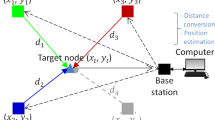Abstract
The distance estimation between nodes is a crucial requirement for localization and object tracking. Received signal strength (RSS) measurement is one of the used methods for the distance estimation in wireless networks. Its main advantage is that there are no additional hardware requirements. This paper describes a lateration approach for localization and distance estimation using RSS. For the purpose of investigation of RSS uncertainty, several scenarios were designed for both indoor and outdoor measurements. The first set of RSS measurement scenarios was proposed with the intention of hardware independent investigation of radio channel. For the second set of measurements, we employed IRIS sensor nodes to evaluate the distance estimation with certain devices. The experiments considered also obstacles in the radio channel. The results obtained in the proposed scenarios present usability of the method under different conditions. There is also a signal propagation model constructed from measured data at a node, which subsequently serves for distance determination.
Similar content being viewed by others
References
Macha, T., Martinasek, Z., & Stancik, S. (2009). Impact of scattering models on connectivity in sensor network. In 32nd international conference on telecommunications and signal processing (p. 5).
Akyildiz, I. F., Su, W., Sankarasubramaniam, Y., & Cayirci, E. (2002). Wireless sensor networks: a survey. Computer Networks, 38(4), 393–422.
Simek, M., Komosny, D., Burget, R., & Sa Silva, J. (2008). Multicast routing in wireless sensor network. In Telecommunication and signal processing (pp. 54–59).
Camilo, T., Rodrigues, A., Silva, J., & Boavida, F. (2008). Management of mobility in wireless sensor networks. In IEEE international symposium on a world of wireless mobile and multimedia networks.
Hightower, J., & Borriello, G. (2001). Location systems for ubiquitous computing. Computer, 34(8), 57–66.
Moravek, P., Komosny, D., Sveda, J., et al. (2009). Vivaldi and other localization methods. In 32nd international conference on telecommunications and signal processing (pp. 214–218).
IEEE Standard for Information Technology Part 15.4: Wireless Medium Access Control (MAC) and Physical Layer (PHY) specifications for Low-Rate Wireless Personal Area Networks (LR-WPANs), IEEE Std 802.15.4-2003.
Stoyanova, T., Kerasiotis, F., Prayati, A., & Papadopoulos, G. (2009). A practical RF propagation model for wireless network sensors. In Third international conference on sensor technologies and applications (pp. 194–199).
Rappaport, T. (2001). Wireless communications: principles and practice (2nd ed.). New York: Prentice Hall.
Jakes, W. C. (1974). Microwave mobile communications. New York: Wiley. Reprinted by IEEE Press in 1994.
Patwari, N., Ash, J. N., Kyperountas, S., Hero, A. O., Moses, R. L., & Correal, N. S. (2005). Locating the nodes: cooperative localization in wireless sensor networks. IEEE Signal Processing Magazine, 22(4), 54–69.
Moravek, P., Girbau, G., Lazaro, A., & Komosny, D. (2010). Received signal strength uncertainty in energy-aware localization in wireless sensor networks. In 9th international conference on environment and electrical engineering EEEIC, Prague.
Cho, H., Kang, M., Park, J., Park, B., & Kim, H. (2007). Performance analysis of location estimation algorithm in zigbee networks using received signal strength. In Advanced information networking and applications workshops.
Jianwu, Z., & Lu, Z. (2009). Research on distance measurement based on RSSI of ZigBee. ISECS International Colloquium on Computing, Communication, Control, and Management, 3, 210–212.
Mao, G., Anderson, B., & Fidan, B. (2007). Path loss exponent estimation for wireless sensor network localization. Computer Networks, 51(10), 2467–2483.
Parameswaran, A. T., Husain, M. H., & Upadhyaya, S. (2009). Is RSSI a reliable parameter in sensor localization algorithms—an experimental study. In Field failure data analysis workshop (F2DA’09), New York.
Seybold, J. (2005). Introduction to RF propagation. New Jersey: Wiley.
Chrysikos, T., & Kotsopoulos, S. (2009). Impact of channel-dependent variation of path loss exponent on wireless information-theoretic security. In Wireless telecommunications symposium (pp. 1–7).
Author information
Authors and Affiliations
Corresponding author
Rights and permissions
About this article
Cite this article
Moravek, P., Komosny, D., Simek, M. et al. Investigation of radio channel uncertainty in distance estimation in wireless sensor networks. Telecommun Syst 52, 1549–1558 (2013). https://doi.org/10.1007/s11235-011-9522-4
Published:
Issue Date:
DOI: https://doi.org/10.1007/s11235-011-9522-4




